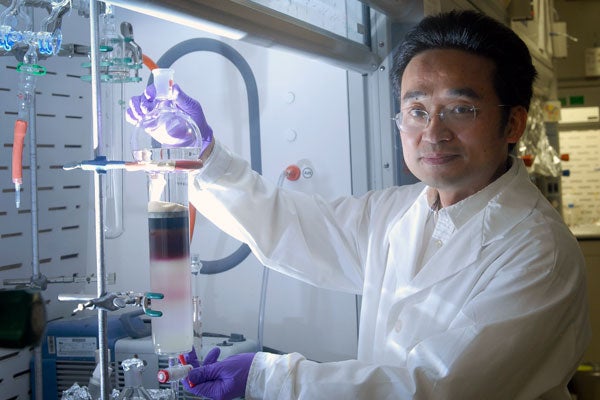
Tiny sensor may have big impact in tackling cancer, cystic fibrosis
Published: December 15, 2015
A new sensor developed at the University of Toronto that provides greater accuracy in pH measurement may help in better understanding and diagnosing a range of diseases including cancer.
“Being able to detect pH levels in a living biological system in real time is crucial to detecting and understanding conditions associated with pH imbalance,” says Assistant Professor Xiao-an Zhang, who is an expert in developing chemical probes for biomedical imaging.
“To do this you need a method that allows you to explore deeply into the tissue without being invasive, and accurate while still being useful in a variety of situations.”
An imbalance in pH levels can lead to a number of disorders. For example, low pH has been linked to such pathological conditions as cystic fibrosis, ischemia and cancer.
“You can use a pH signal to diagnose a disease and also monitor the effectiveness of a therapy,” says Zhang, of the chemistry department at the University of Toronto Scarborough . “So it’s important to know when and where there is significant pH change within human tissues.”
The sensor developed by Zhang and his team uses Nuclear Magnetic Resonance (NMR) spectroscopy technology, which offers a very detailed look at molecules at the atomic level in a noninvasive manner. Testing of the sensors was done on oocytes (fish egg cells) in collaboration with Professor Andre Simpson’s NMR lab at UTSC, and U of T Professor Deborah Zamble’s lab using E.coli cells as subjects.
A pH value is a measurement of the activity of protons, which are tiny charged particles that tend to attach to other molecules. They are hard to measure in tissues because they move rapidly, making it difficult to capture molecular location using conventional NMR timescales, notes Zhang.
The major challenge in using NMR technology for pH measurement is taking a detailed image of molecules at different protonation states, which is a molecule with or without a proton attached. While various NMR imaging techniques do exist they don’t offer an accurate enough picture in real time of different protonation states. The sensor developed by Zhang offers a unique solution to that dilemma by offering a slow proton exchange mechanism.
“The probe we developed can slow down proton movement and view protons at various states. It can clearly see both protonation states so it makes for a more sensitive and accurate measurement,” adds Zhang.
While the immediate goal is to use the sensors in medical imaging, Zhang says they could have applications in other fields such as environmental science, biology and food studies, including food production and quality control.
The research, which will be published in Chemical Science, received funding through an NSERC Discovery Grant and a CIHR Operating Grant.



